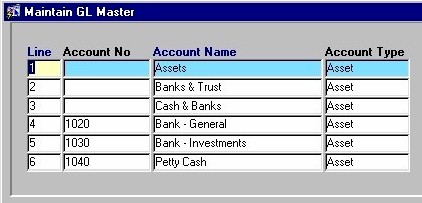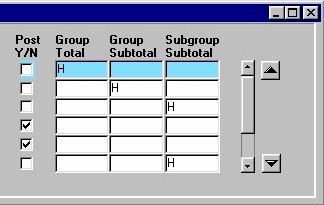Maintain General Ledger Master
The General Ledger Master entity defines the Firm's chart of accounts (a listing of all the General Ledger Account Titles and Account Numbers being used within a Company/Firm), and is configured when eQuinox is first installed. It will facilitate the General Ledger account structure displayed below. Rows marked with an "*" represent totaling or subtotaling groups.
*Assets
* Banks & Trust
*Cash & Banks
1110 Bank
1120 ST Loans
*Subtotal Cash & Banks
*Subtotal Banks & Trust
*Trust Funds
*1200 Long Term Assets
The General Ledger Master routine also allows the user to enter new General Ledger account information, or edit existing General Ledger account details. An existing General Ledger Master entry may not be deleted if dependent General Ledger transactions exist. Once any necessary changes have been made, the user must click the Save button on the menu bar to commit the changes and update the system with the new information. To exit the screen without saving any changes, simply click the Exit button on the menu bar.
When the Maintain GL Master routine is accessed from the eQuinox main menu, the screen shown below will be displayed.
F.Y.I.
General Ledger - An accounting system that includes a separate record for each item in the Balance Sheet. For example, a separate record is kept for the asset Cash, showing all the increases and decreases in Cash that result from the many transactions in which cash is received or paid. A similar record is kept for every other asset, liability, and owner's equity. The form of record used to record increases and decreases in a single Balance Sheet item is called a General Ledger Account.
General Ledger Account - A General Ledger Account is a means of accumulating in one place all the information about changes in a specific asset, liability, or owner's equity. For example, a General Ledger Account for the asset Cash provides a record of the amount of cash receipts, cash payments, and the current cash balance. Accounts are usually arranged in the General Ledger in financial statement order; Assets first, followed by Liabilities, Owners Equity, Revenue, and Expenses. The General Ledger Accounts serve as the basis for preparing the Balance Sheet and other financial statements.
General Ledger Journal - Each business transaction is initially recorded in the General Ledger Journal. The Journal is a chronological record of business transactions, including the date of the transaction, the debit and credit changes in specific General Ledger Accounts, and a brief explanation of the transaction. After the transactions are entered into the Journal, the debit and credit changes in the individual Accounts are entered into the Ledger.
Field Definition

Line - The ordering sequence of the General Ledger accounts, used for reporting purposes.
Account No - The assigned account number for the current General Ledger account. When entering new accounts the user must enter both the Account Number and Account Name.
Account Name - The assigned name/ description of the current General Ledger account. When entering new accounts the user must enter both the Account Number and Account Name.

Account Type - The type of General Ledger account (i.e. Asset, Liability, Equity, Expense, etc). For entering or editing purposes, the account type may be selected from the List of Values provided.
Post Y/N - The Yes/No (checked/unchecked) status of this field determines whether or not the current General Ledger account can be posted to during transactions throughout the system.
Group Total - The Group Totaling indicator in the General Ledger.
Group Subtotal - The Group Subtotal indicator. This represents the first level of subtotaling in the General Ledger.
Subgroup Subtotal - The Subgroup Subtotal indicator. This represents the second level of subtotaling in the General Ledger.
Up/Down Arrows - The Up and Down Arrow buttons to the right of the scroll bar allow the user to quickly access the first and last records (i.e. the Up Arrow button automatically sets focus to the first GL Account record; the Down Arrow button automatically sets focus to the last GL Account record.
When the user has completed making any necessary changes, they must either click the Save button or press F10 to commit the information.